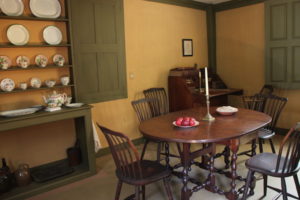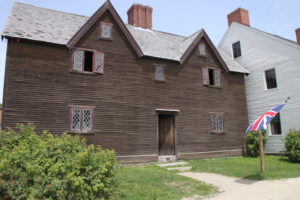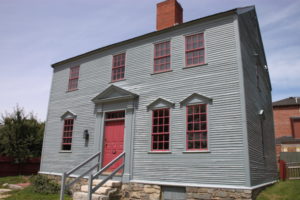When we were kids, Mom taught my sister Marilyn and me to sew. But weaving? It wasn’t relevant.
Fast forward to 2017 and, this summer, I had my first experience at a loom. In other circumstances, I think I could get good enough to make decent-looking towels, or something, but I couldn’t loiter over the loom on this occasion.
My sister and I were visiting an outdoor history museum in Portsmouth, N.H., and we had a lot of territory to cover. The Strawbery Banke Museum, 10 acres right in the heart of town, got its start as an urban renewal project after residents were moved out in 1954.
The private nonprofit developer saved 29 buildings, mostly houses (the oldest from c. 1695), which remain on their original foundations. Six more were relocated to the site to save them from demolition, including a former Daniel Webster home (built c.1785) and a former governor’s mansion. A few newer buildings support museum operations.
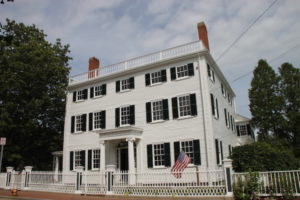
The Gov. Goodwin Mansion, near the Strawbery Banke entry point. The house, dating from 1832-1896, was home to Civil War Gov. Ichabod Goodwin and moved to the museum site to save it from demolition.
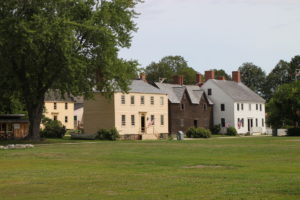
A string of houses, still on original foundations, at the Strawbery Banke Museum (from left): Lowd House, built c. 1810; Sherburne House, c. 1695/1703, and Shapley-Drisco House, c. 1795.
Strawbery Banke was the original early 17th century name for Portsmouth. The museum’s neighborhood had its own name, too — Puddle Dock.
The two side-by-side Cotton Tenant Houses, built in Puddle Dock the 1830s as rentals, accommodate basket-making and weaving demonstrations, including the visitor option to try weaving. The exteriors have been restored, not so the interiors, not yet. This museum is a work in progress.
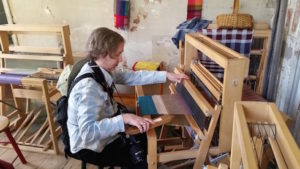
I am serious about trying my hand at weaving after a demonstration at the Strawbery Banke Museum — and my sister cannot resist the photo op.
A second demonstration, of 18th century cooking in the c. 1780 Wheelwright House, was even more alluring. That had the appeal of the exotic, considering the vast differences between open hearth cooking and, say, an electric stovetop today.
Our Wheelwright hostess was preparing raw foods for cooking, based on 18th century food choices. On the day we visited, this included bacon and onions with some spices.
Cooking over an open fire wastes a LOT of heat and is dangerous. Our hostess said burns were the second-highest cause of death (after childbirth) among colonial women but not because their dresses caught fire. They died when burns became infected. (Elsewhere on our New England journey, we were told women routinely dampened and tied up the bottoms of their skirts.)
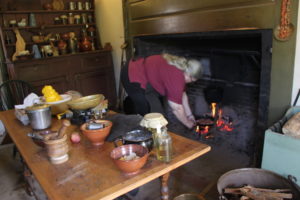
A Strawbery Banke staffer demonstrates 18th century open-hearth cooking in the restored kitchen of the c. 1780 Wheelwright House. There’s bacon in the pan she is placing over the fire.
When entering Strawbery Banke, we were given that day’s visitor’s guide, which told us where to find these demonstrations and also where some of the museum’s several role players would appear.
Which is how we came to visit the restored c. 1766 Pitt Tavern. It sits exactly where it sat when George Washington met here with local dignitaries; he traveled through the Northeast in autumn 1789, not long after his inauguration as president the previous April.
However, the on-site role player, identified in our visitor’s guide as “Mrs. Margaret Davis, daughter of the tavern keeper,” was tending to daily chores, and the year was 1777, before Washington turned up.
The establishment had several rooms where guests might sit at table to eat, drink and play checkers or other board games.
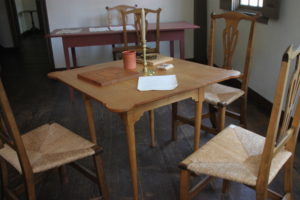
Table and chairs in the Pitt Tavern, set up for board games typical of the 1770s. Those games could include checkers, games with marbles and something called the game of fox and geese.
“Mrs. Davis” was poised to prepare food for the tavern’s customers. She said women as well as men came to the tavern, and they did not necessarily come with male companions. She said the women generally stuck together in a room apart, but they could go into any room.
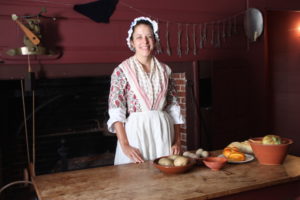
“Mrs. Margaret Davis,” who is set up to prepare a meal for 1777 guests at the Pitt Tavern, smiles upon seeing an invention from the future — the camera.
Three role players were on site the day we visited; at its Web site, the museum lists a cast of 11 who appear at varying times.
Strawbery Banke also counts several recreated period gardens, additional restored houses that we did not see and a few shops illustrating period businesses, but Marilyn and I were itching to see more of Portsmouth during our single day in town. I have more on that in a separate posting here: https://besttripchoices.com/my-travel-corner/portsmouth-n-h-beyond-strawbery-banke/
In addition, for more about Portsmouth in general, we offer at BestTripChoices.com the following, under the headline: A place of Distinction
https://besttripchoices.com/us-cities/portsmouth-new-hampshire/
This blog is by Nadine Godwin, BestTripChoices.com editorial director and contributor to the trade newspaper, Travel Weekly. She also is the author of “Travia: The Ultimate Book of Travel Trivia.” Photos are by Nadine Godwin except where she appears in the shot; the photographer in that case is Marilyn Gooch.

